Tourist Management Strategies and Recommendations: Sirromet Winery
VerifiedAdded on 2021/05/31
|12
|2215
|23
Report
AI Summary
This report provides an in-depth analysis of tourist management strategies at Sirromet Winery, a popular destination near Brisbane, Australia. The report begins with a description of the winery, including its facilities, wine production methods, and attractions. It then identifies key management issues, such as crowding and congestion, lack of accessibility, inadequate signage, and insufficient information provision. The report also examines current management practices at the site, highlighting both strengths and weaknesses in areas like marketing, staff coordination, and security. Based on these observations, the report offers several recommendations for improvement, including better crowd management, enhanced accessibility for disabled visitors, improved signage and information services, and the use of technology to enhance the tourist experience. The report concludes by emphasizing the importance of these recommendations for enhancing the destination's sustainability and overall visitor satisfaction.
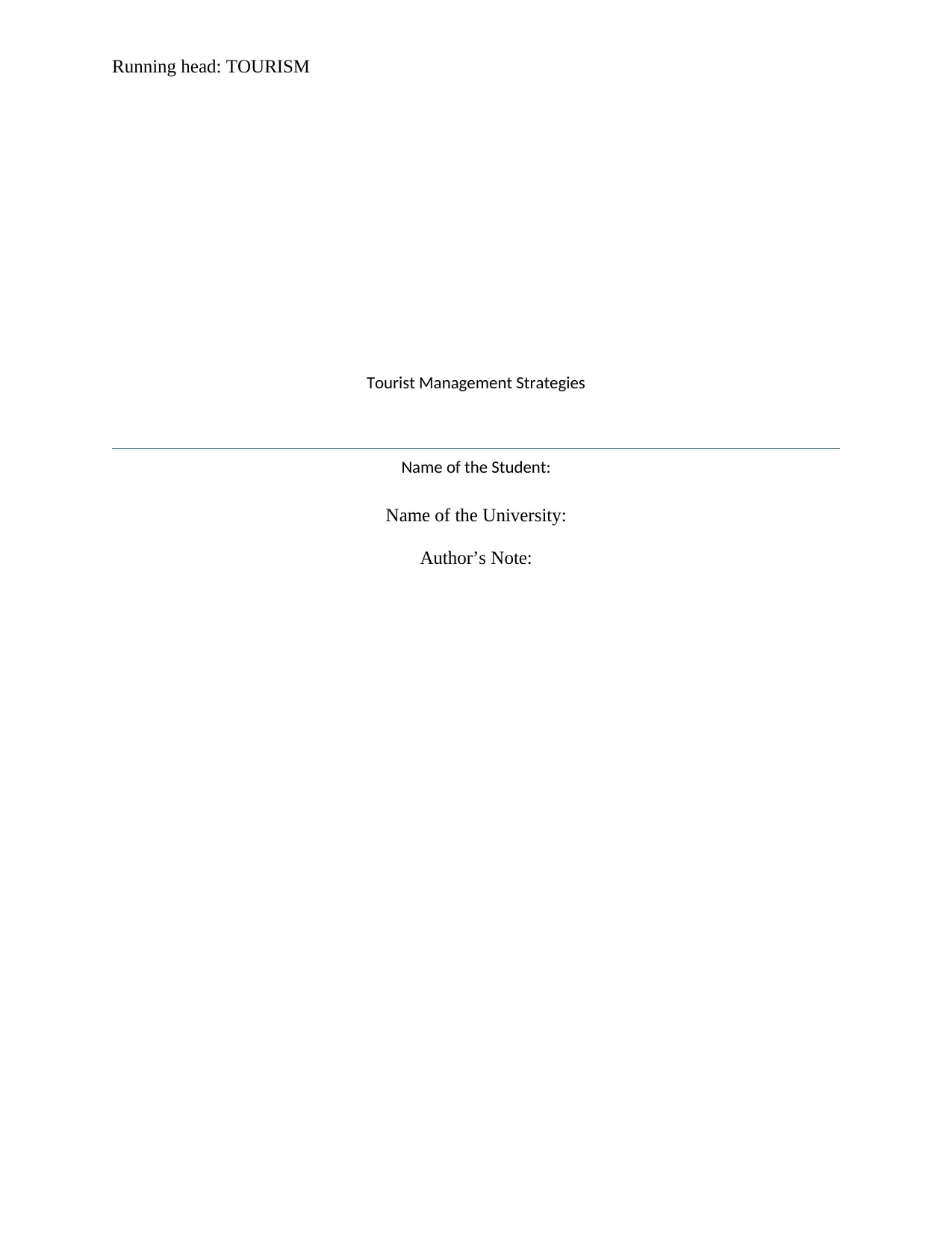
Running head: TOURISM
Tourist Management Strategies
Name of the Student:
Name of the University:
Author’s Note:
Tourist Management Strategies
Name of the Student:
Name of the University:
Author’s Note:
Paraphrase This Document
Need a fresh take? Get an instant paraphrase of this document with our AI Paraphraser
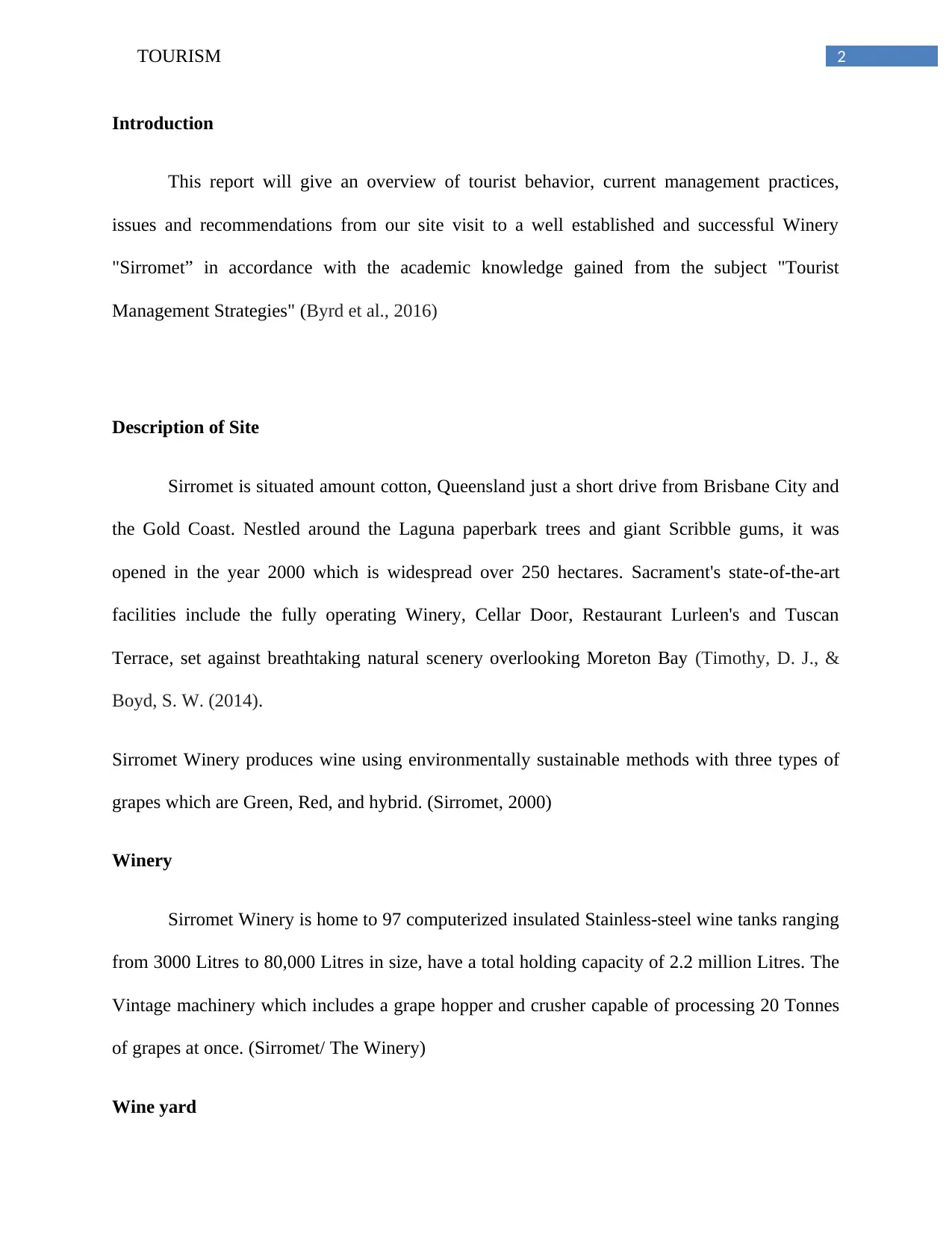
2TOURISM
Introduction
This report will give an overview of tourist behavior, current management practices,
issues and recommendations from our site visit to a well established and successful Winery
"Sirromet” in accordance with the academic knowledge gained from the subject "Tourist
Management Strategies" (Byrd et al., 2016)
Description of Site
Sirromet is situated amount cotton, Queensland just a short drive from Brisbane City and
the Gold Coast. Nestled around the Laguna paperbark trees and giant Scribble gums, it was
opened in the year 2000 which is widespread over 250 hectares. Sacrament's state-of-the-art
facilities include the fully operating Winery, Cellar Door, Restaurant Lurleen's and Tuscan
Terrace, set against breathtaking natural scenery overlooking Moreton Bay (Timothy, D. J., &
Boyd, S. W. (2014).
Sirromet Winery produces wine using environmentally sustainable methods with three types of
grapes which are Green, Red, and hybrid. (Sirromet, 2000)
Winery
Sirromet Winery is home to 97 computerized insulated Stainless-steel wine tanks ranging
from 3000 Litres to 80,000 Litres in size, have a total holding capacity of 2.2 million Litres. The
Vintage machinery which includes a grape hopper and crusher capable of processing 20 Tonnes
of grapes at once. (Sirromet/ The Winery)
Wine yard
Introduction
This report will give an overview of tourist behavior, current management practices,
issues and recommendations from our site visit to a well established and successful Winery
"Sirromet” in accordance with the academic knowledge gained from the subject "Tourist
Management Strategies" (Byrd et al., 2016)
Description of Site
Sirromet is situated amount cotton, Queensland just a short drive from Brisbane City and
the Gold Coast. Nestled around the Laguna paperbark trees and giant Scribble gums, it was
opened in the year 2000 which is widespread over 250 hectares. Sacrament's state-of-the-art
facilities include the fully operating Winery, Cellar Door, Restaurant Lurleen's and Tuscan
Terrace, set against breathtaking natural scenery overlooking Moreton Bay (Timothy, D. J., &
Boyd, S. W. (2014).
Sirromet Winery produces wine using environmentally sustainable methods with three types of
grapes which are Green, Red, and hybrid. (Sirromet, 2000)
Winery
Sirromet Winery is home to 97 computerized insulated Stainless-steel wine tanks ranging
from 3000 Litres to 80,000 Litres in size, have a total holding capacity of 2.2 million Litres. The
Vintage machinery which includes a grape hopper and crusher capable of processing 20 Tonnes
of grapes at once. (Sirromet/ The Winery)
Wine yard
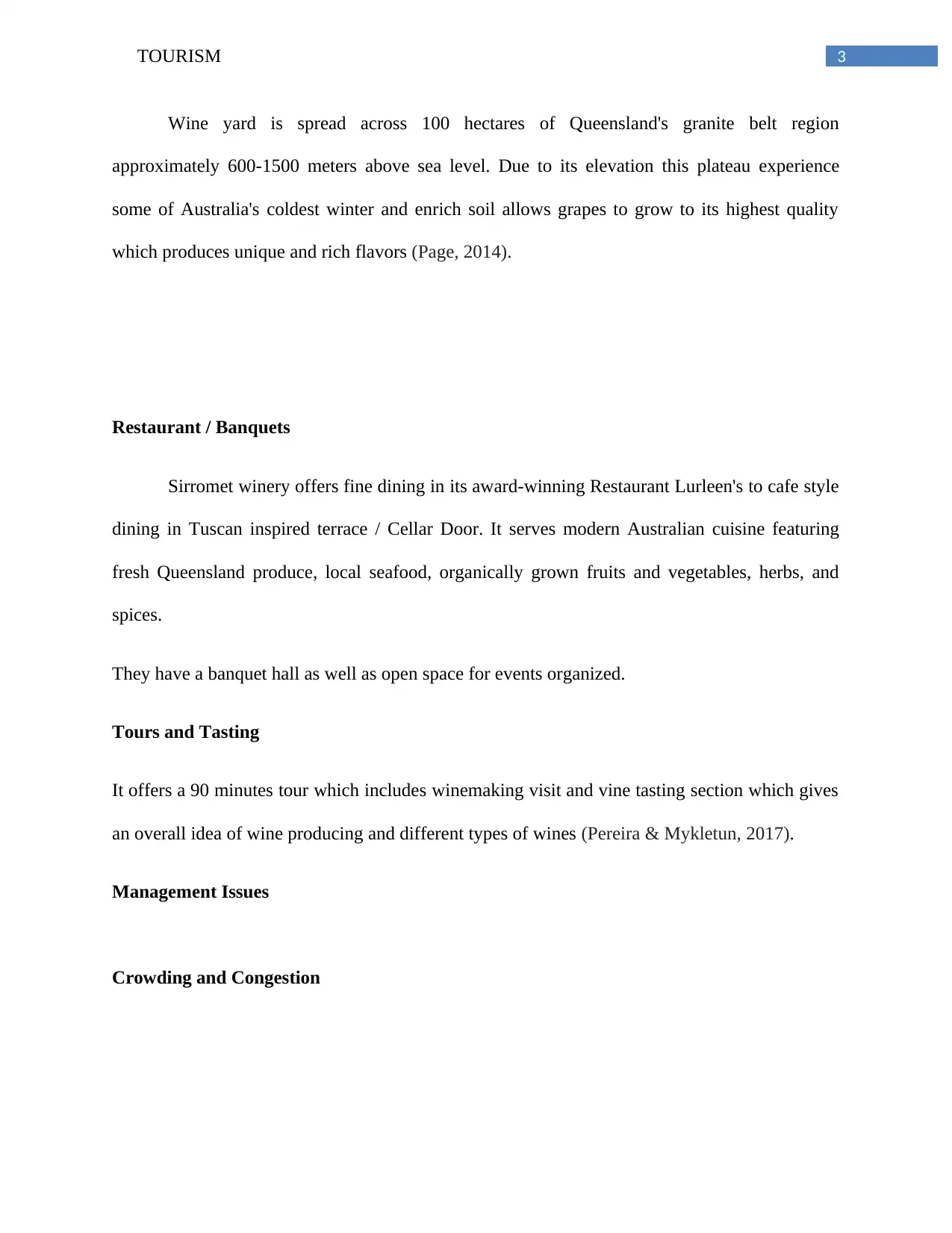
3TOURISM
Wine yard is spread across 100 hectares of Queensland's granite belt region
approximately 600-1500 meters above sea level. Due to its elevation this plateau experience
some of Australia's coldest winter and enrich soil allows grapes to grow to its highest quality
which produces unique and rich flavors (Page, 2014).
Restaurant / Banquets
Sirromet winery offers fine dining in its award-winning Restaurant Lurleen's to cafe style
dining in Tuscan inspired terrace / Cellar Door. It serves modern Australian cuisine featuring
fresh Queensland produce, local seafood, organically grown fruits and vegetables, herbs, and
spices.
They have a banquet hall as well as open space for events organized.
Tours and Tasting
It offers a 90 minutes tour which includes winemaking visit and vine tasting section which gives
an overall idea of wine producing and different types of wines (Pereira & Mykletun, 2017).
Management Issues
Crowding and Congestion
Wine yard is spread across 100 hectares of Queensland's granite belt region
approximately 600-1500 meters above sea level. Due to its elevation this plateau experience
some of Australia's coldest winter and enrich soil allows grapes to grow to its highest quality
which produces unique and rich flavors (Page, 2014).
Restaurant / Banquets
Sirromet winery offers fine dining in its award-winning Restaurant Lurleen's to cafe style
dining in Tuscan inspired terrace / Cellar Door. It serves modern Australian cuisine featuring
fresh Queensland produce, local seafood, organically grown fruits and vegetables, herbs, and
spices.
They have a banquet hall as well as open space for events organized.
Tours and Tasting
It offers a 90 minutes tour which includes winemaking visit and vine tasting section which gives
an overall idea of wine producing and different types of wines (Pereira & Mykletun, 2017).
Management Issues
Crowding and Congestion
⊘ This is a preview!⊘
Do you want full access?
Subscribe today to unlock all pages.

Trusted by 1+ million students worldwide
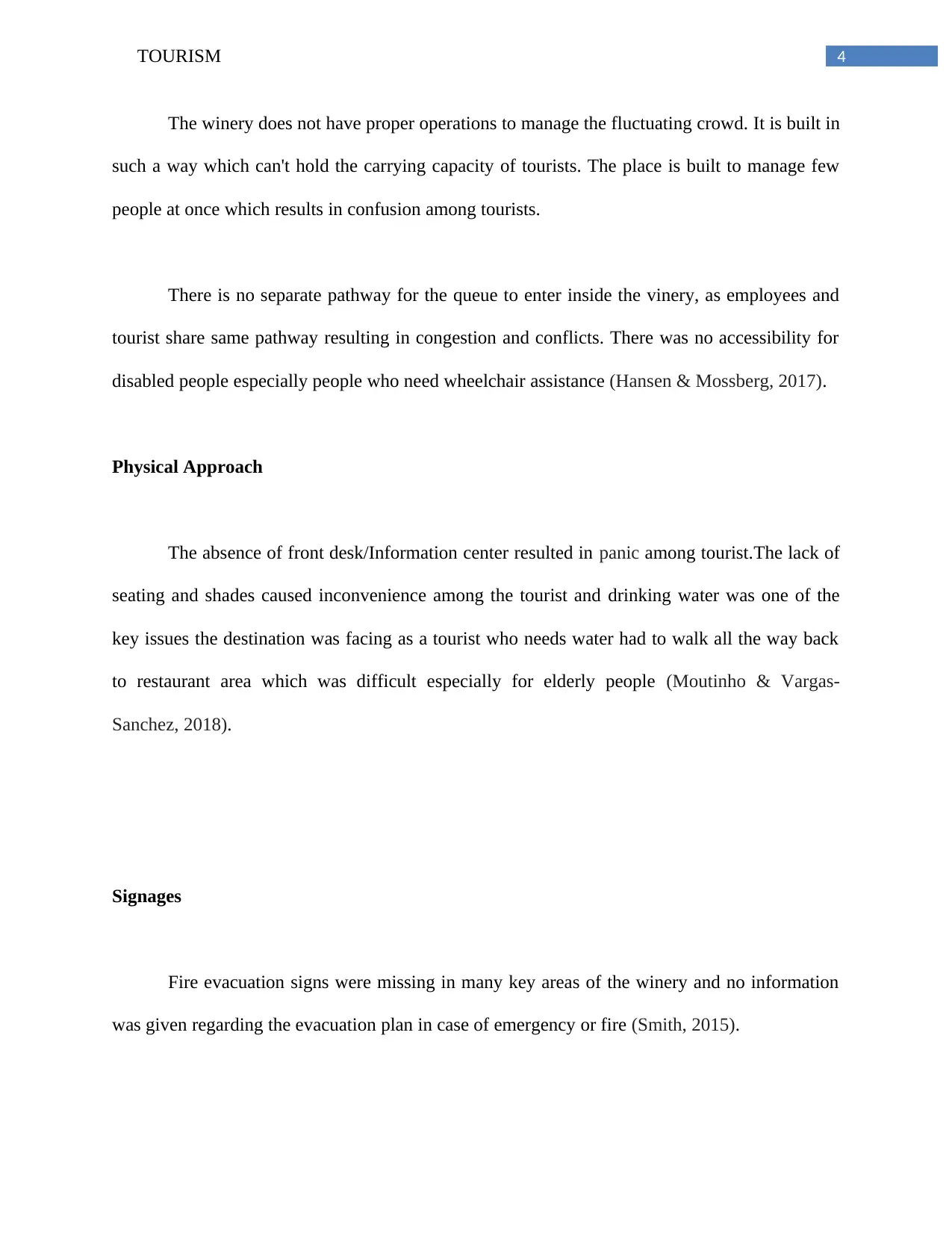
4TOURISM
The winery does not have proper operations to manage the fluctuating crowd. It is built in
such a way which can't hold the carrying capacity of tourists. The place is built to manage few
people at once which results in confusion among tourists.
There is no separate pathway for the queue to enter inside the vinery, as employees and
tourist share same pathway resulting in congestion and conflicts. There was no accessibility for
disabled people especially people who need wheelchair assistance (Hansen & Mossberg, 2017).
Physical Approach
The absence of front desk/Information center resulted in panic among tourist.The lack of
seating and shades caused inconvenience among the tourist and drinking water was one of the
key issues the destination was facing as a tourist who needs water had to walk all the way back
to restaurant area which was difficult especially for elderly people (Moutinho & Vargas-
Sanchez, 2018).
Signages
Fire evacuation signs were missing in many key areas of the winery and no information
was given regarding the evacuation plan in case of emergency or fire (Smith, 2015).
The winery does not have proper operations to manage the fluctuating crowd. It is built in
such a way which can't hold the carrying capacity of tourists. The place is built to manage few
people at once which results in confusion among tourists.
There is no separate pathway for the queue to enter inside the vinery, as employees and
tourist share same pathway resulting in congestion and conflicts. There was no accessibility for
disabled people especially people who need wheelchair assistance (Hansen & Mossberg, 2017).
Physical Approach
The absence of front desk/Information center resulted in panic among tourist.The lack of
seating and shades caused inconvenience among the tourist and drinking water was one of the
key issues the destination was facing as a tourist who needs water had to walk all the way back
to restaurant area which was difficult especially for elderly people (Moutinho & Vargas-
Sanchez, 2018).
Signages
Fire evacuation signs were missing in many key areas of the winery and no information
was given regarding the evacuation plan in case of emergency or fire (Smith, 2015).
Paraphrase This Document
Need a fresh take? Get an instant paraphrase of this document with our AI Paraphraser
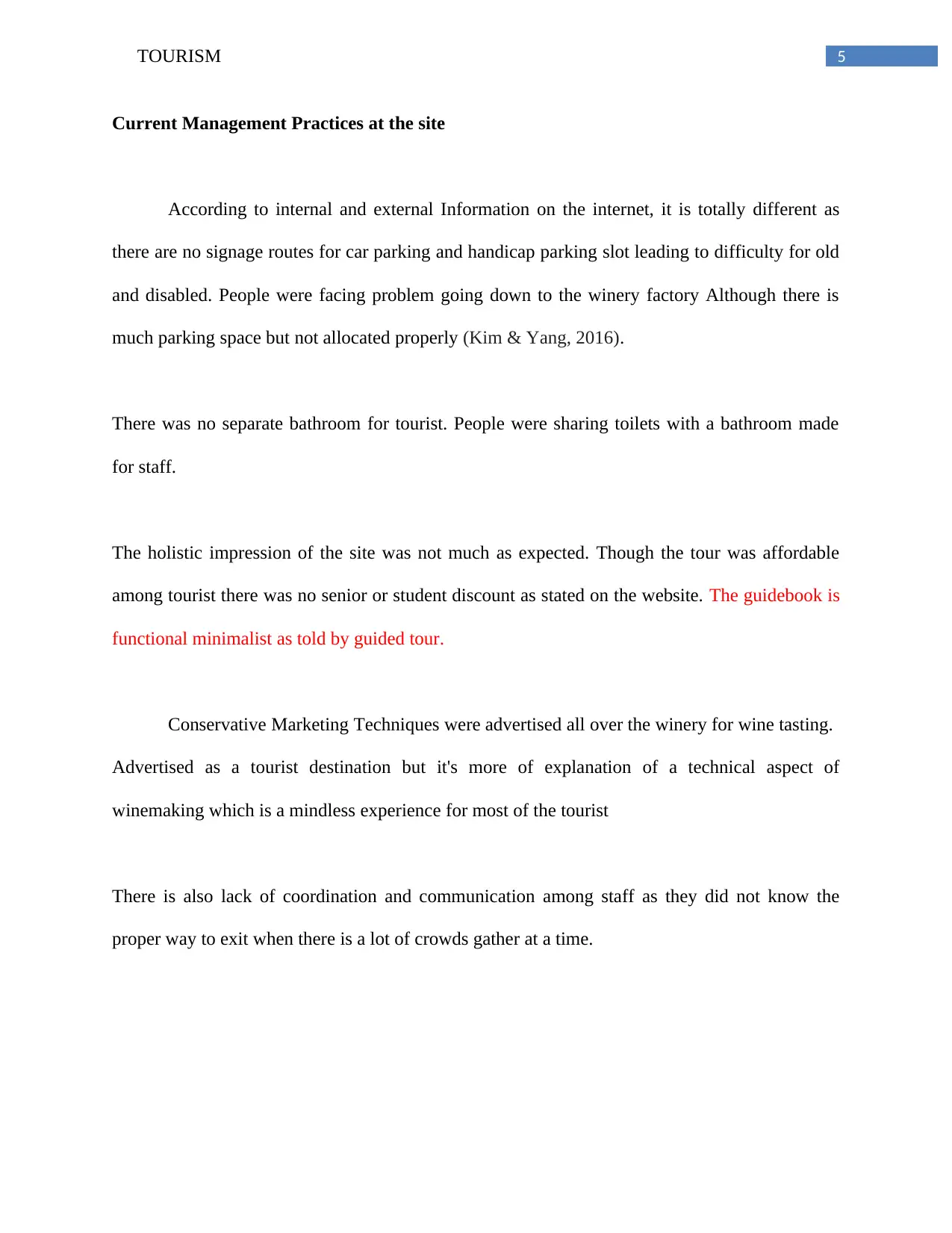
5TOURISM
Current Management Practices at the site
According to internal and external Information on the internet, it is totally different as
there are no signage routes for car parking and handicap parking slot leading to difficulty for old
and disabled. People were facing problem going down to the winery factory Although there is
much parking space but not allocated properly (Kim & Yang, 2016).
There was no separate bathroom for tourist. People were sharing toilets with a bathroom made
for staff.
The holistic impression of the site was not much as expected. Though the tour was affordable
among tourist there was no senior or student discount as stated on the website. The guidebook is
functional minimalist as told by guided tour.
Conservative Marketing Techniques were advertised all over the winery for wine tasting.
Advertised as a tourist destination but it's more of explanation of a technical aspect of
winemaking which is a mindless experience for most of the tourist
There is also lack of coordination and communication among staff as they did not know the
proper way to exit when there is a lot of crowds gather at a time.
Current Management Practices at the site
According to internal and external Information on the internet, it is totally different as
there are no signage routes for car parking and handicap parking slot leading to difficulty for old
and disabled. People were facing problem going down to the winery factory Although there is
much parking space but not allocated properly (Kim & Yang, 2016).
There was no separate bathroom for tourist. People were sharing toilets with a bathroom made
for staff.
The holistic impression of the site was not much as expected. Though the tour was affordable
among tourist there was no senior or student discount as stated on the website. The guidebook is
functional minimalist as told by guided tour.
Conservative Marketing Techniques were advertised all over the winery for wine tasting.
Advertised as a tourist destination but it's more of explanation of a technical aspect of
winemaking which is a mindless experience for most of the tourist
There is also lack of coordination and communication among staff as they did not know the
proper way to exit when there is a lot of crowds gather at a time.
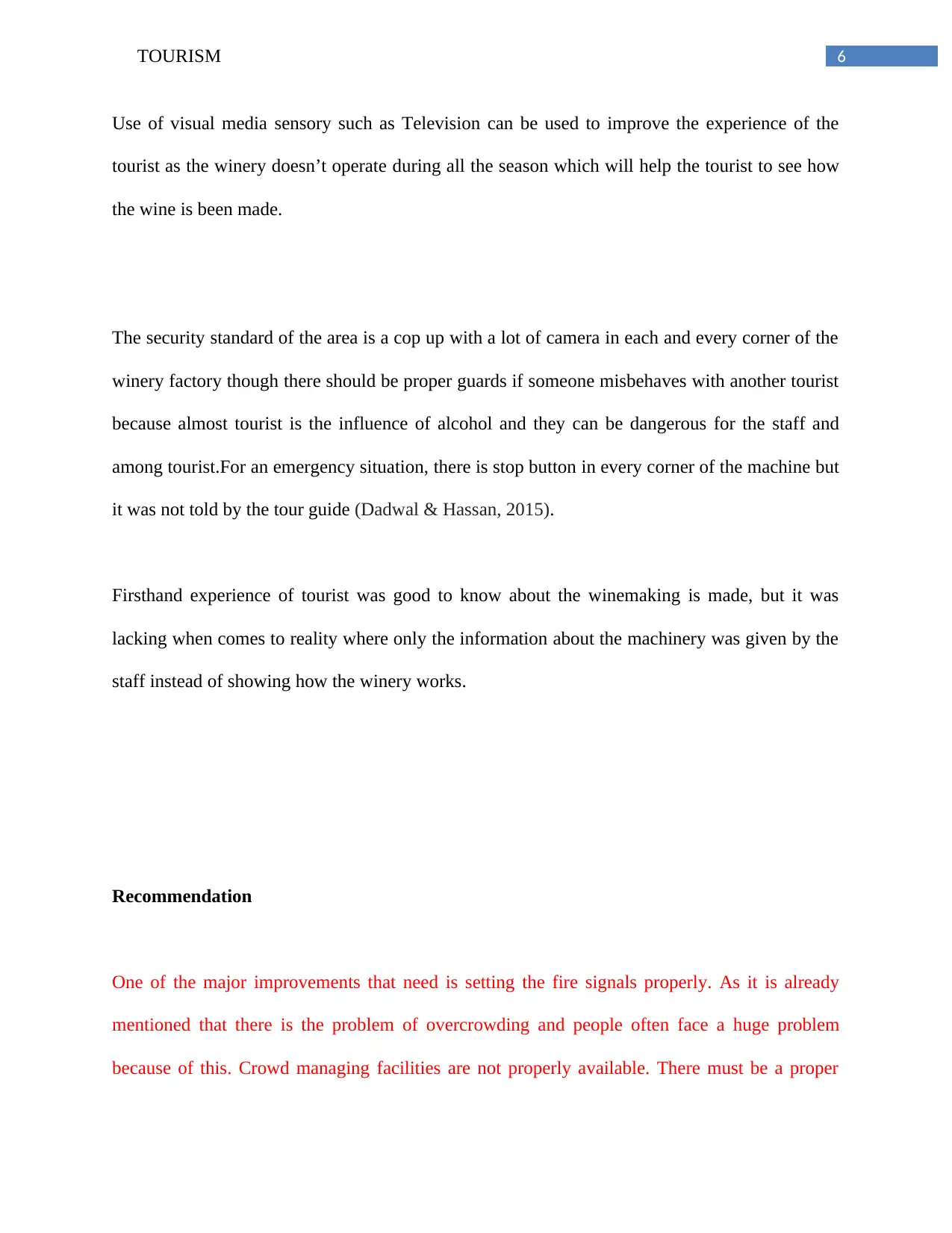
6TOURISM
Use of visual media sensory such as Television can be used to improve the experience of the
tourist as the winery doesn’t operate during all the season which will help the tourist to see how
the wine is been made.
The security standard of the area is a cop up with a lot of camera in each and every corner of the
winery factory though there should be proper guards if someone misbehaves with another tourist
because almost tourist is the influence of alcohol and they can be dangerous for the staff and
among tourist.For an emergency situation, there is stop button in every corner of the machine but
it was not told by the tour guide (Dadwal & Hassan, 2015).
Firsthand experience of tourist was good to know about the winemaking is made, but it was
lacking when comes to reality where only the information about the machinery was given by the
staff instead of showing how the winery works.
Recommendation
One of the major improvements that need is setting the fire signals properly. As it is already
mentioned that there is the problem of overcrowding and people often face a huge problem
because of this. Crowd managing facilities are not properly available. There must be a proper
Use of visual media sensory such as Television can be used to improve the experience of the
tourist as the winery doesn’t operate during all the season which will help the tourist to see how
the wine is been made.
The security standard of the area is a cop up with a lot of camera in each and every corner of the
winery factory though there should be proper guards if someone misbehaves with another tourist
because almost tourist is the influence of alcohol and they can be dangerous for the staff and
among tourist.For an emergency situation, there is stop button in every corner of the machine but
it was not told by the tour guide (Dadwal & Hassan, 2015).
Firsthand experience of tourist was good to know about the winemaking is made, but it was
lacking when comes to reality where only the information about the machinery was given by the
staff instead of showing how the winery works.
Recommendation
One of the major improvements that need is setting the fire signals properly. As it is already
mentioned that there is the problem of overcrowding and people often face a huge problem
because of this. Crowd managing facilities are not properly available. There must be a proper
⊘ This is a preview!⊘
Do you want full access?
Subscribe today to unlock all pages.

Trusted by 1+ million students worldwide
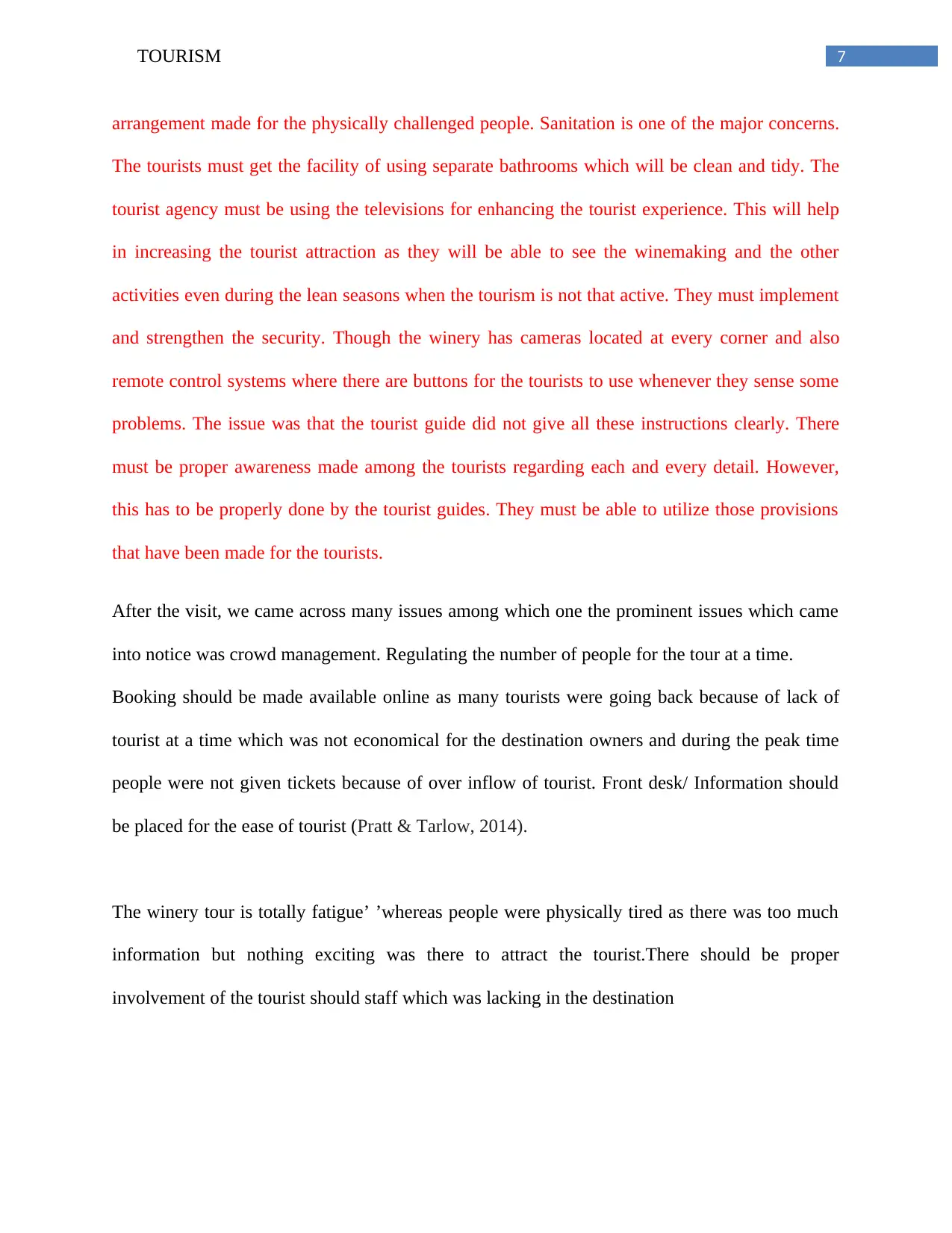
7TOURISM
arrangement made for the physically challenged people. Sanitation is one of the major concerns.
The tourists must get the facility of using separate bathrooms which will be clean and tidy. The
tourist agency must be using the televisions for enhancing the tourist experience. This will help
in increasing the tourist attraction as they will be able to see the winemaking and the other
activities even during the lean seasons when the tourism is not that active. They must implement
and strengthen the security. Though the winery has cameras located at every corner and also
remote control systems where there are buttons for the tourists to use whenever they sense some
problems. The issue was that the tourist guide did not give all these instructions clearly. There
must be proper awareness made among the tourists regarding each and every detail. However,
this has to be properly done by the tourist guides. They must be able to utilize those provisions
that have been made for the tourists.
After the visit, we came across many issues among which one the prominent issues which came
into notice was crowd management. Regulating the number of people for the tour at a time.
Booking should be made available online as many tourists were going back because of lack of
tourist at a time which was not economical for the destination owners and during the peak time
people were not given tickets because of over inflow of tourist. Front desk/ Information should
be placed for the ease of tourist (Pratt & Tarlow, 2014).
The winery tour is totally fatigue’ ’whereas people were physically tired as there was too much
information but nothing exciting was there to attract the tourist.There should be proper
involvement of the tourist should staff which was lacking in the destination
arrangement made for the physically challenged people. Sanitation is one of the major concerns.
The tourists must get the facility of using separate bathrooms which will be clean and tidy. The
tourist agency must be using the televisions for enhancing the tourist experience. This will help
in increasing the tourist attraction as they will be able to see the winemaking and the other
activities even during the lean seasons when the tourism is not that active. They must implement
and strengthen the security. Though the winery has cameras located at every corner and also
remote control systems where there are buttons for the tourists to use whenever they sense some
problems. The issue was that the tourist guide did not give all these instructions clearly. There
must be proper awareness made among the tourists regarding each and every detail. However,
this has to be properly done by the tourist guides. They must be able to utilize those provisions
that have been made for the tourists.
After the visit, we came across many issues among which one the prominent issues which came
into notice was crowd management. Regulating the number of people for the tour at a time.
Booking should be made available online as many tourists were going back because of lack of
tourist at a time which was not economical for the destination owners and during the peak time
people were not given tickets because of over inflow of tourist. Front desk/ Information should
be placed for the ease of tourist (Pratt & Tarlow, 2014).
The winery tour is totally fatigue’ ’whereas people were physically tired as there was too much
information but nothing exciting was there to attract the tourist.There should be proper
involvement of the tourist should staff which was lacking in the destination
Paraphrase This Document
Need a fresh take? Get an instant paraphrase of this document with our AI Paraphraser
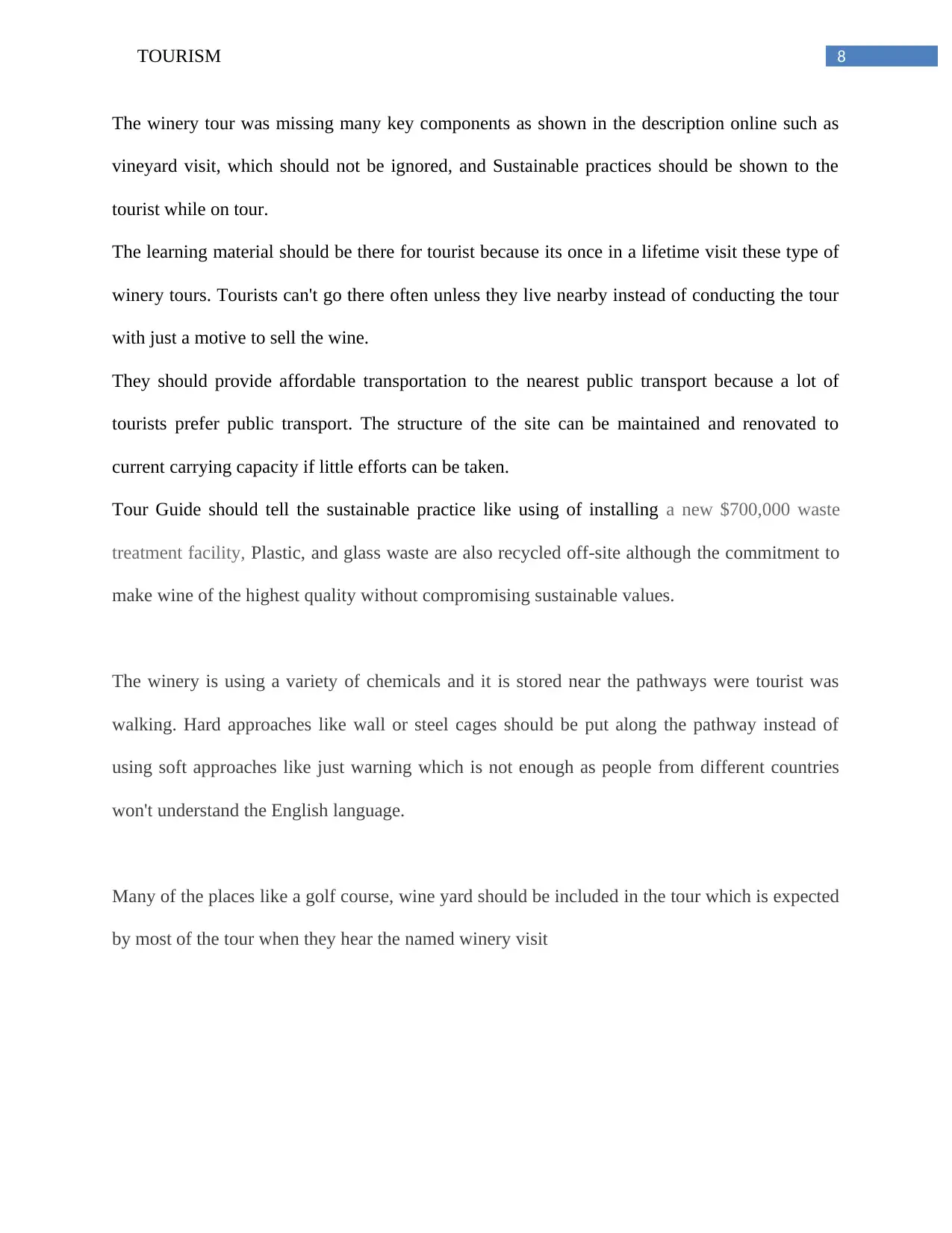
8TOURISM
The winery tour was missing many key components as shown in the description online such as
vineyard visit, which should not be ignored, and Sustainable practices should be shown to the
tourist while on tour.
The learning material should be there for tourist because its once in a lifetime visit these type of
winery tours. Tourists can't go there often unless they live nearby instead of conducting the tour
with just a motive to sell the wine.
They should provide affordable transportation to the nearest public transport because a lot of
tourists prefer public transport. The structure of the site can be maintained and renovated to
current carrying capacity if little efforts can be taken.
Tour Guide should tell the sustainable practice like using of installing a new $700,000 waste
treatment facility, Plastic, and glass waste are also recycled off-site although the commitment to
make wine of the highest quality without compromising sustainable values.
The winery is using a variety of chemicals and it is stored near the pathways were tourist was
walking. Hard approaches like wall or steel cages should be put along the pathway instead of
using soft approaches like just warning which is not enough as people from different countries
won't understand the English language.
Many of the places like a golf course, wine yard should be included in the tour which is expected
by most of the tour when they hear the named winery visit
The winery tour was missing many key components as shown in the description online such as
vineyard visit, which should not be ignored, and Sustainable practices should be shown to the
tourist while on tour.
The learning material should be there for tourist because its once in a lifetime visit these type of
winery tours. Tourists can't go there often unless they live nearby instead of conducting the tour
with just a motive to sell the wine.
They should provide affordable transportation to the nearest public transport because a lot of
tourists prefer public transport. The structure of the site can be maintained and renovated to
current carrying capacity if little efforts can be taken.
Tour Guide should tell the sustainable practice like using of installing a new $700,000 waste
treatment facility, Plastic, and glass waste are also recycled off-site although the commitment to
make wine of the highest quality without compromising sustainable values.
The winery is using a variety of chemicals and it is stored near the pathways were tourist was
walking. Hard approaches like wall or steel cages should be put along the pathway instead of
using soft approaches like just warning which is not enough as people from different countries
won't understand the English language.
Many of the places like a golf course, wine yard should be included in the tour which is expected
by most of the tour when they hear the named winery visit
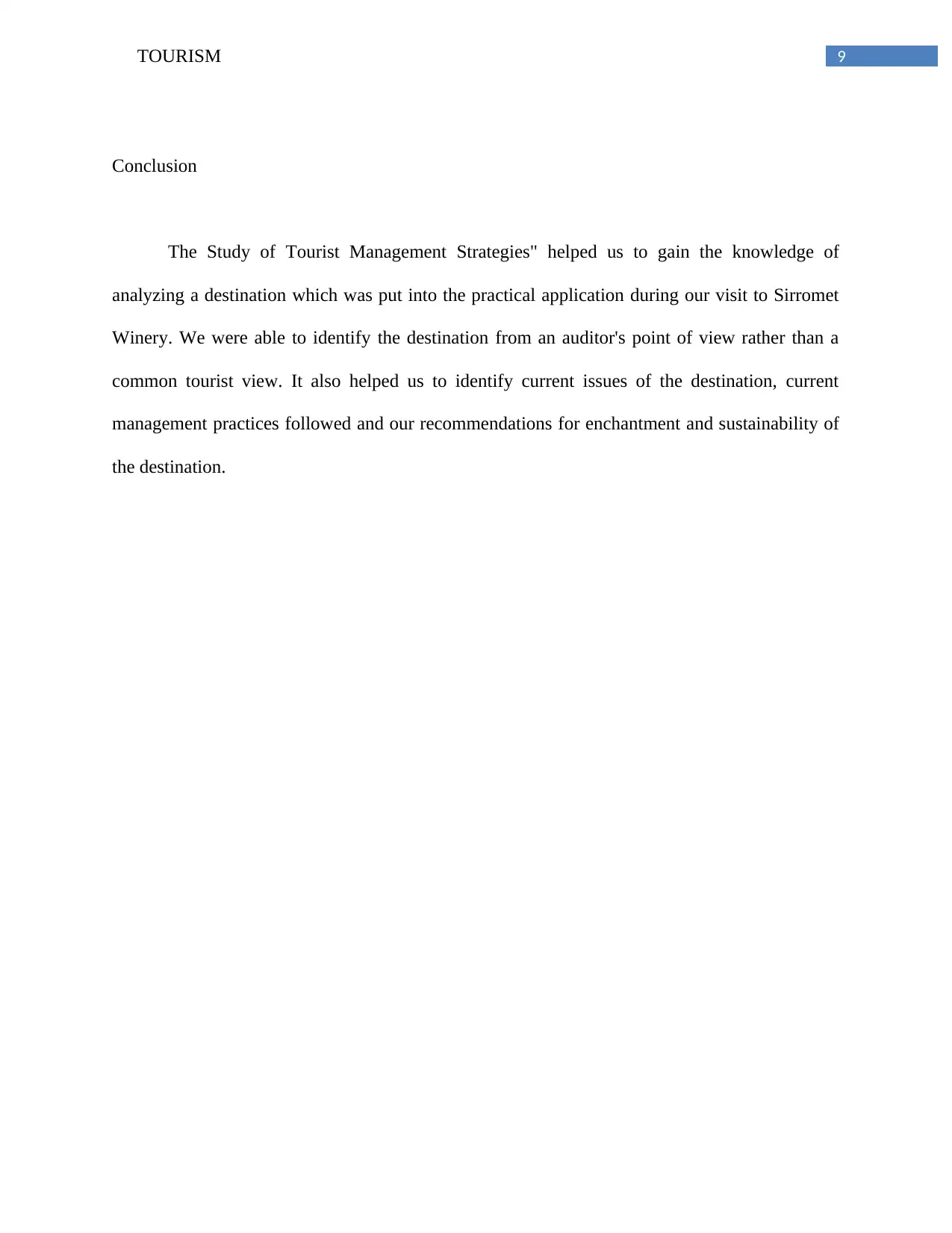
9TOURISM
Conclusion
The Study of Tourist Management Strategies" helped us to gain the knowledge of
analyzing a destination which was put into the practical application during our visit to Sirromet
Winery. We were able to identify the destination from an auditor's point of view rather than a
common tourist view. It also helped us to identify current issues of the destination, current
management practices followed and our recommendations for enchantment and sustainability of
the destination.
Conclusion
The Study of Tourist Management Strategies" helped us to gain the knowledge of
analyzing a destination which was put into the practical application during our visit to Sirromet
Winery. We were able to identify the destination from an auditor's point of view rather than a
common tourist view. It also helped us to identify current issues of the destination, current
management practices followed and our recommendations for enchantment and sustainability of
the destination.
⊘ This is a preview!⊘
Do you want full access?
Subscribe today to unlock all pages.

Trusted by 1+ million students worldwide
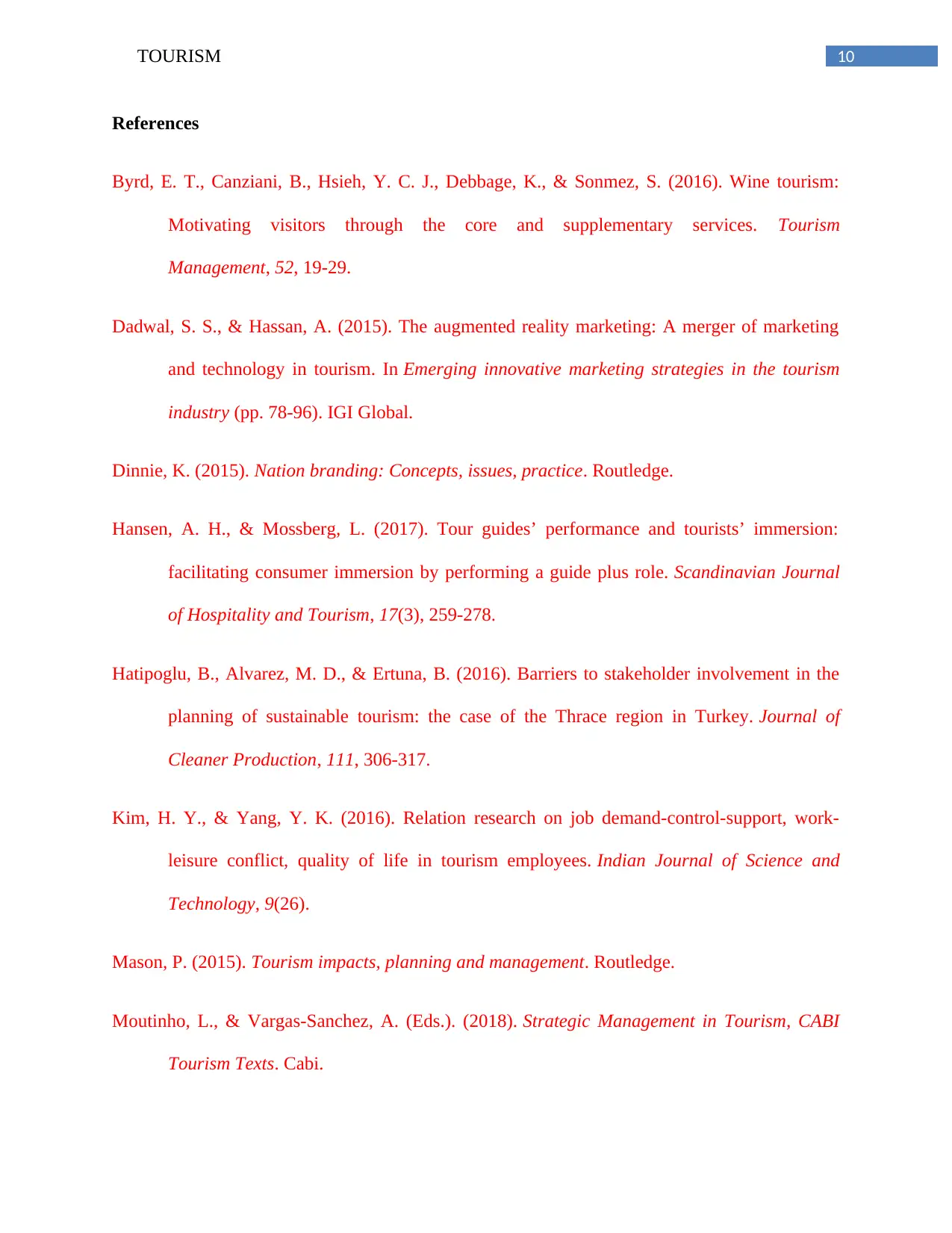
10TOURISM
References
Byrd, E. T., Canziani, B., Hsieh, Y. C. J., Debbage, K., & Sonmez, S. (2016). Wine tourism:
Motivating visitors through the core and supplementary services. Tourism
Management, 52, 19-29.
Dadwal, S. S., & Hassan, A. (2015). The augmented reality marketing: A merger of marketing
and technology in tourism. In Emerging innovative marketing strategies in the tourism
industry (pp. 78-96). IGI Global.
Dinnie, K. (2015). Nation branding: Concepts, issues, practice. Routledge.
Hansen, A. H., & Mossberg, L. (2017). Tour guides’ performance and tourists’ immersion:
facilitating consumer immersion by performing a guide plus role. Scandinavian Journal
of Hospitality and Tourism, 17(3), 259-278.
Hatipoglu, B., Alvarez, M. D., & Ertuna, B. (2016). Barriers to stakeholder involvement in the
planning of sustainable tourism: the case of the Thrace region in Turkey. Journal of
Cleaner Production, 111, 306-317.
Kim, H. Y., & Yang, Y. K. (2016). Relation research on job demand-control-support, work-
leisure conflict, quality of life in tourism employees. Indian Journal of Science and
Technology, 9(26).
Mason, P. (2015). Tourism impacts, planning and management. Routledge.
Moutinho, L., & Vargas-Sanchez, A. (Eds.). (2018). Strategic Management in Tourism, CABI
Tourism Texts. Cabi.
References
Byrd, E. T., Canziani, B., Hsieh, Y. C. J., Debbage, K., & Sonmez, S. (2016). Wine tourism:
Motivating visitors through the core and supplementary services. Tourism
Management, 52, 19-29.
Dadwal, S. S., & Hassan, A. (2015). The augmented reality marketing: A merger of marketing
and technology in tourism. In Emerging innovative marketing strategies in the tourism
industry (pp. 78-96). IGI Global.
Dinnie, K. (2015). Nation branding: Concepts, issues, practice. Routledge.
Hansen, A. H., & Mossberg, L. (2017). Tour guides’ performance and tourists’ immersion:
facilitating consumer immersion by performing a guide plus role. Scandinavian Journal
of Hospitality and Tourism, 17(3), 259-278.
Hatipoglu, B., Alvarez, M. D., & Ertuna, B. (2016). Barriers to stakeholder involvement in the
planning of sustainable tourism: the case of the Thrace region in Turkey. Journal of
Cleaner Production, 111, 306-317.
Kim, H. Y., & Yang, Y. K. (2016). Relation research on job demand-control-support, work-
leisure conflict, quality of life in tourism employees. Indian Journal of Science and
Technology, 9(26).
Mason, P. (2015). Tourism impacts, planning and management. Routledge.
Moutinho, L., & Vargas-Sanchez, A. (Eds.). (2018). Strategic Management in Tourism, CABI
Tourism Texts. Cabi.
Paraphrase This Document
Need a fresh take? Get an instant paraphrase of this document with our AI Paraphraser
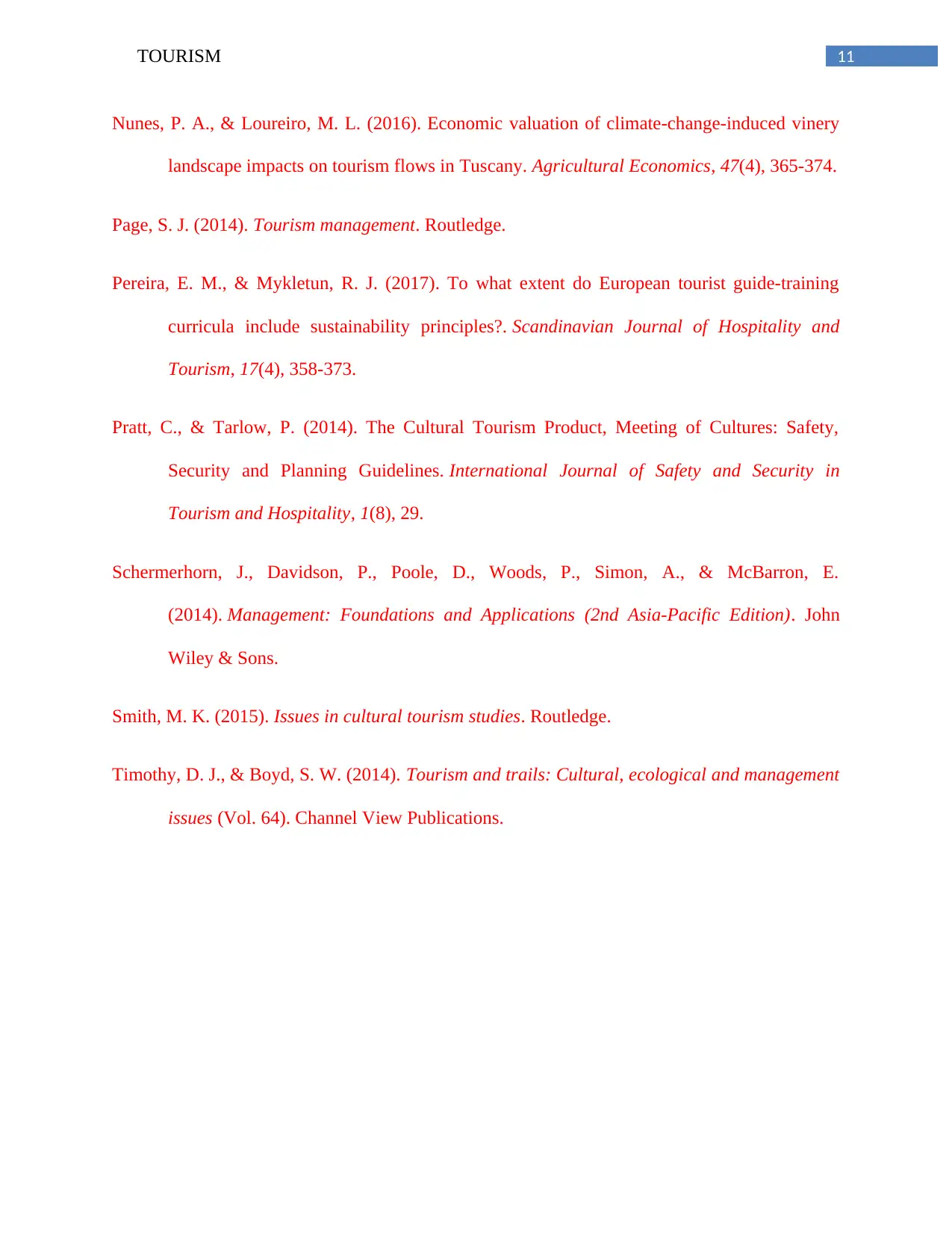
11TOURISM
Nunes, P. A., & Loureiro, M. L. (2016). Economic valuation of climate‐change‐induced vinery
landscape impacts on tourism flows in Tuscany. Agricultural Economics, 47(4), 365-374.
Page, S. J. (2014). Tourism management. Routledge.
Pereira, E. M., & Mykletun, R. J. (2017). To what extent do European tourist guide-training
curricula include sustainability principles?. Scandinavian Journal of Hospitality and
Tourism, 17(4), 358-373.
Pratt, C., & Tarlow, P. (2014). The Cultural Tourism Product, Meeting of Cultures: Safety,
Security and Planning Guidelines. International Journal of Safety and Security in
Tourism and Hospitality, 1(8), 29.
Schermerhorn, J., Davidson, P., Poole, D., Woods, P., Simon, A., & McBarron, E.
(2014). Management: Foundations and Applications (2nd Asia-Pacific Edition). John
Wiley & Sons.
Smith, M. K. (2015). Issues in cultural tourism studies. Routledge.
Timothy, D. J., & Boyd, S. W. (2014). Tourism and trails: Cultural, ecological and management
issues (Vol. 64). Channel View Publications.
Nunes, P. A., & Loureiro, M. L. (2016). Economic valuation of climate‐change‐induced vinery
landscape impacts on tourism flows in Tuscany. Agricultural Economics, 47(4), 365-374.
Page, S. J. (2014). Tourism management. Routledge.
Pereira, E. M., & Mykletun, R. J. (2017). To what extent do European tourist guide-training
curricula include sustainability principles?. Scandinavian Journal of Hospitality and
Tourism, 17(4), 358-373.
Pratt, C., & Tarlow, P. (2014). The Cultural Tourism Product, Meeting of Cultures: Safety,
Security and Planning Guidelines. International Journal of Safety and Security in
Tourism and Hospitality, 1(8), 29.
Schermerhorn, J., Davidson, P., Poole, D., Woods, P., Simon, A., & McBarron, E.
(2014). Management: Foundations and Applications (2nd Asia-Pacific Edition). John
Wiley & Sons.
Smith, M. K. (2015). Issues in cultural tourism studies. Routledge.
Timothy, D. J., & Boyd, S. W. (2014). Tourism and trails: Cultural, ecological and management
issues (Vol. 64). Channel View Publications.

12TOURISM
⊘ This is a preview!⊘
Do you want full access?
Subscribe today to unlock all pages.

Trusted by 1+ million students worldwide
1 out of 12
Your All-in-One AI-Powered Toolkit for Academic Success.
+13062052269
info@desklib.com
Available 24*7 on WhatsApp / Email
![[object Object]](/_next/static/media/star-bottom.7253800d.svg)
Unlock your academic potential
Copyright © 2020–2025 A2Z Services. All Rights Reserved. Developed and managed by ZUCOL.
